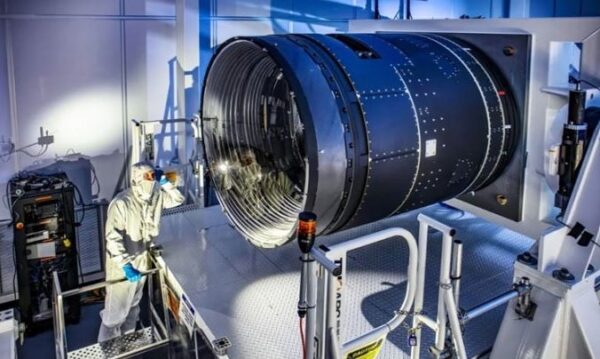With its 3,200-megapixel LSST camera, the Vera C. Rubin observatory can uncover the secrets of dark matter and dark energy.
The Vera C. Rubin Observatory will soon begin the Legacy Survey of Space and Time (LSST) mission, monitoring the entire sky in the Southern Hemisphere thousands of times. This massive scale mission requires a camera of corresponding caliber. The SLAC National Accelerator Laboratory is in charge of providing such equipment. Scientists and engineers at SLAC completed the LSST camera, the world’s largest digital camera for a pioneering 10-year survey, Space reported on April 3.
The LSST camera is complete and ready for transport to the Vera C.Rubin observatory. (Photo: SLAC).
The 3,200-megapixel LSST camera is as big as a small car and weighs 3 tons, half the weight of a male African elephant. LSST’s wide-field observation capabilities will help uncover many mysteries surrounding dark energy, the force that accounts for about 70% of the universe’s energy density and accelerates the expansion of the universe. LSST will also explore dark matter, which accounts for 85% of the matter in the universe even though it cannot be seen with the naked eye, and answer many other astronomical questions, according to Željko Ivezić, director in charge of building the observatory. Vera C. Rubin.
Aaron Roodman, a professor at SLAC who is deputy director of the Vera C. Rubin Observatory and in charge of the camera program, said the LSST survey will help observe billions of galaxies, an estimated 17 billion stars in the Milky Way and thousands of stars. billion objects in the Solar System. Photos taken from the LSST camera are so detailed that a golf ball can be clearly seen from a distance of 24 km, and can observe an area of sky 7 times larger than the full moon.
One of the main advantages of LSST surveys is the repeated observations of the same airspace over and over again. This will help scientists accurately track any changes occurring in that area over a 10-year period. They will witness transient events such as supernova explosions that brighten and fade, curve light from distant sources, caused by the gravitational pull of passing material, and monitor the expansion of the space field, pushing more distant galaxies farther away. Those galaxies will slide faster and faster under the influence of dark energy.
Before the LSST camera can help researchers understand dark energy and other cosmic mysteries, it needs to be transported from the SLAC facility in Menlo Park, California to the 2,713-meter peak of Cerro Pachón in the Andes in Chile. Once there, the camera will be placed on top of the Simonyi survey telescope later this year.
It’s not just the size of the LSST camera that makes transportation extremely difficult. This camera is also exceptionally fragile, with a focal plane consisting of 201 custom-designed CCD sensors. These sensors are only 5 microns thick, with a difference in thickness no more than 1/10 the width of a human hair. Compared to them, a sheet of paper is 50 – 100 microns thick.
The distance between the sensors is about half a millimeter, meaning preventing them from colliding with each other is a major challenge in manufacturing and transportation. The team tested the route for the LSST camera, using a simulator of the same weight and shape as the camera. They also installed an accelerometer on the object to check the pressure exerted on the camera like the journey to Chile by plane. Once the LSST is in place, the equipment will be installed and put into operation. The first photos of LSST will be published next spring.











